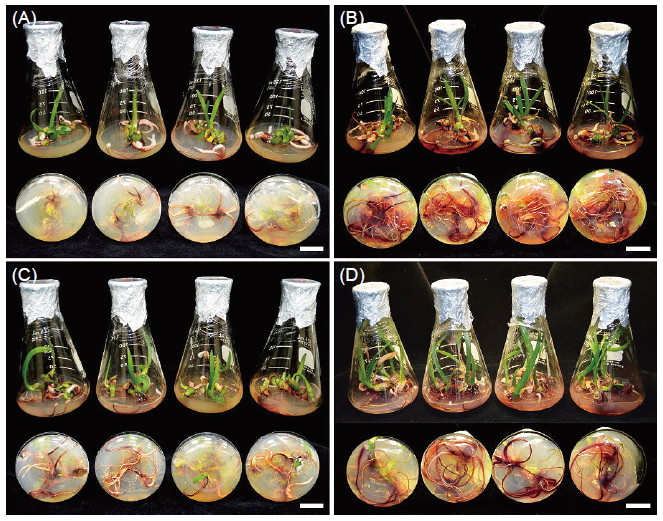All issues

Author:Uei-Chern Chen, I. Din, Tzu-Ying Wu, Jhin-Yi Tsao, and Chi-Ni Hsia*
Abstract:
Field-grown bulbs of Amaryllis (Hippeastrum hybridum) ‘Red Lion’ (about 25 cm circumference), ‘Blossom Peacock’, and ‘Tainung No. 1-Pink Lady’ (about 12 cm circumference) were used as culture materials. Effects of surface disinfection, explant type, and plant growth regulators combinations on establishment in vitro bulblet proliferation were investigated. Stem explants (2 cm × 1 cm × 1 cm) of ‘Red Lion’ left on a filter paper overnight before using 1.2% sodium hypochlorite solution for 15 min resulted in the least contamination. Stem explants (6 mm × 6 mm × 2 mm) cut from the upper or lower part of ‘Tainung No. 1-Pink Lady’ were compared. Although explants derived from different positions of the stem had the same proliferation rates of 1.2 bulblets per explant, the upper stem explants had a significant lower contamination rate of 3% than that of 37% from the lower part explants. Comparison of proliferation efficiencies was conducted using half- and quarter-bulb explants of ‘Blossom Peacock’ derived from an in vitro bulb with 2.5 cm circumference in size, and no significant difference was found on bulblet formation between both treatments. However, a higher proliferation rate of 5.2 bulblets per original bulb was calculated by using quarter-bulb explants than that of 2.0 bulblets from the half-bulb explants. The highest bulblet proliferation rate with 11.6 bulblets from per 2.5 cm circumference in ‘Red Lion’ in vitro bulb was obtained by culturing quarter-bulb explants on the MS medium supplemented with 0.1 mg L-1 thidiazuron (TDZ) and 0.2 mg L-1 α-naphthalene acetic acid (NAA) for 8 wk. Results of this study could provide useful information on bulblet proliferation for new varieties of Amaryllis.
Key words:Hippeastrum hybridum, Disinfection, In vitro propagation, Thidiazuron
Download:![]() PDF Links
PDF Links
- 1. Development of Tractor-Mounted Seedling Transplanter for Sweet Potato
- 2. Synergistic Effect of Additional Gas on the Toxicity of Phosphine to Sitophilus oryzae and Sitophilus zeamais (Coleoptera: Dryophthoridae)
- 3. Effects of Temperature and Solar Radiation on Growth Traits and Plant Elements in Purple Leafy Sweet Potato
 Submit your manuscript
Submit your manuscript
 Guide for authors
Guide for authors